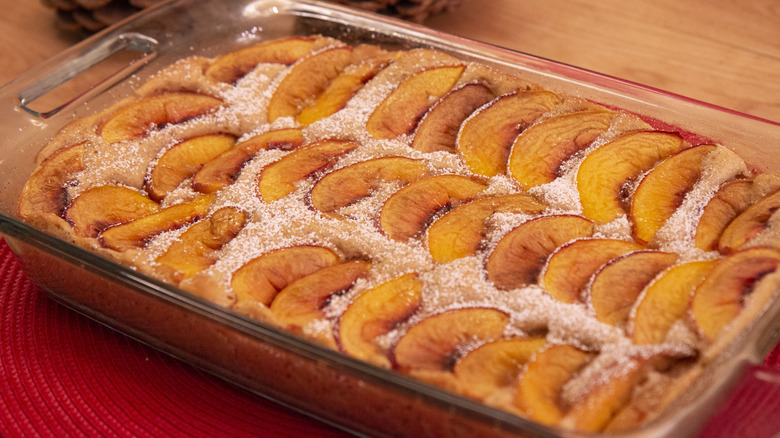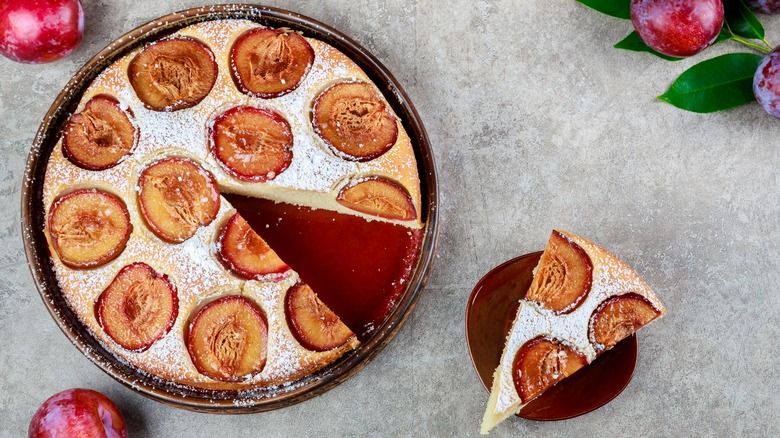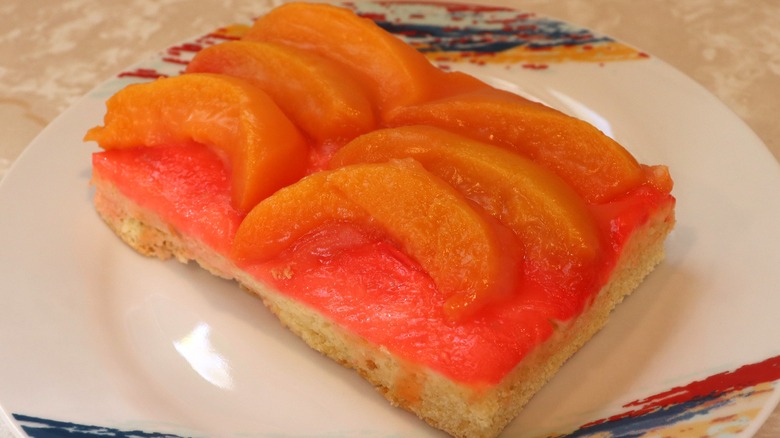Baltimore's Historic Peach Cake Has Rather Mysterious German Origins
Baltimore is packed with hidden food gems that don't get enough attention on the national stage. When outsiders think of Maryland's culinary scene, it's probably blue crabs and Old Bay that come to mind, but residents of the Old Line State know there are so many other tastes to discover. From Maryland-style pit beef to Black-eyed Susangria, Baltimore has something for everyone, and when summer rolls around, there's one fruity dessert you simply must try: peach cake. It's a Baltimore classic with German roots, although exactly when and by whom it was invented is a mystery.
When Americans think of peaches, most think of Georgia, but Maryland has a powerful peach tradition of its own. Peaches are still harvested in Maryland each summer (831 acres were picked in 2017, per Maryland's Best), but the state's reputation for peaches peaked near the turn of the 20th century. This was a time when The Baltimore Sun was replete with peach-centric headlines.
In 1884, the paper estimated peaches were abundant enough for their profits to fund shippers the entire season. In 1886, they reported that around 2.5 million baskets of peaches from the Delmarva Peninsula would be shipped out of Baltimore. And in 1910, The Baltimore Sun ran one of the greatest headlines ever seen in print, which simply said: "Joy — Peaches are Ripe." Around that same time in history, Baltimore experienced waves of German immigration, and when German traditions collided with Maryland's peaches, a beautiful thing was born.
Baltimore peach cake is closely related to German desserts
Baltimore peach cake stands apart from other cakes for a few reasons. It consists of sweet, fluffy dough that's covered with fresh peach slices and baked, after which it's coated in powdered sugar and, in some instances, a glazing of jam. There's no frosting, and the cake is typically made in a rectangular pan, but the most distinct feature that sets peach cake apart is that it's leavened with yeast rather than baking soda or powder. This method is different from so many other cakes in the American baking repertoire, but it points toward Baltimore peach cake's (nearly guaranteed) true origin, in the baking traditions of Germany.
Yeasted cakes may be unusual on the American table, but they are a classic offering in German cuisine. If you compare Baltimore peach cake to Germany's Pfirsichkuchen ("peach cake"), you'll find them nearly identical. Pflamenkuchen ("plum cake") follows the same formula but with a different fruit. There are even savory versions, such as onion cake. In fact, the first time peach cake was ever mentioned in print was in an 1884 The Baltimore Sun article that compared it to German onion cake.
Peach cake evokes strong opinions from Baltimoreans
The peach cake almost certainly has its roots in Baltimore's German immigrant community of the late 19th century, but nobody knows exactly who deserves credit for it. One reporter in the 1980s researched this very problem and discovered everyone in the city just assumed peach cake had been around forever. Though its exact point of origin will likely never be known, it's certain peach cake was considered a local icon by the mid-1900s.
Even so, Baltimoreans have differing opinions on what makes a good peach cake. There has been quite some debate over a few elements, like the jam glaze. Some bakers insist the cake should be topped with nothing more than powdered sugar, while others insist on a glaze to keep the cake looking fresh and presentable. Cinnamon is another controversial addition; only some recipes call for a bit of it to be sprinkled on along with powdered sugar. It seems regional delicacies, as unifying as they may be, never fail to bring out our most opinionated selves.


